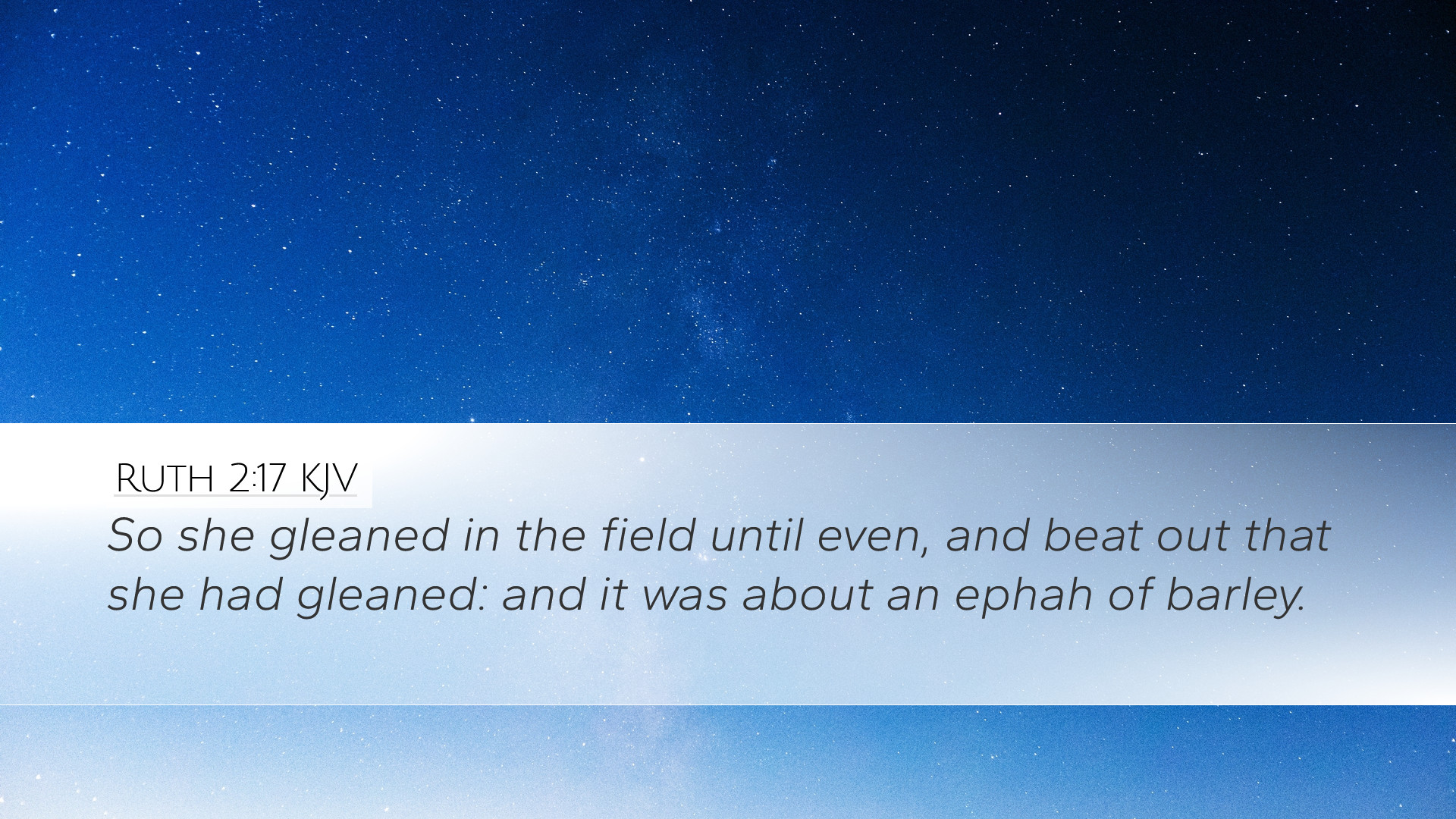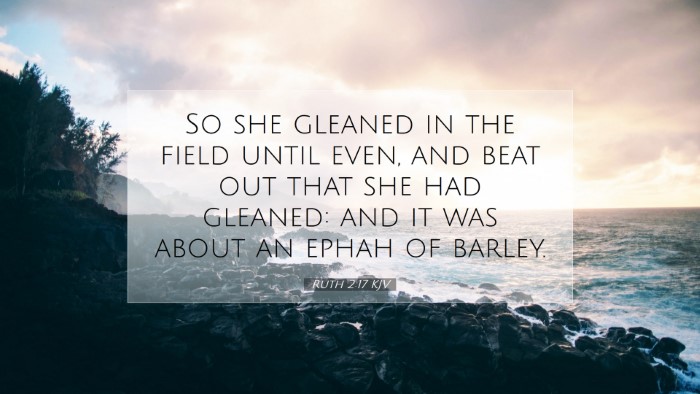Old Testament
Genesis Exodus Leviticus Numbers Deuteronomy Joshua Judges Ruth 1 Samuel 2 Samuel 1 Kings 2 Kings 1 Chronicles 2 Chronicles Ezra Nehemiah Esther Job Psalms Proverbs Ecclesiastes Song of Solomon Isaiah Jeremiah Lamentations Ezekiel Daniel Hosea Joel Amos Obadiah Jonah Micah Nahum Habakkuk Zephaniah Haggai Zechariah MalachiRuth 2:17
Ruth 2:17 KJV
So she gleaned in the field until even, and beat out that she had gleaned: and it was about an ephah of barley.
Ruth 2:17 Bible Commentary
Commentary on Ruth 2:17
The verse Ruth 2:17 states, "So she gleaned in the field until evening, and beat out what she had gleaned; and it was about an ephah of barley." This passage offers rich insights into the themes of providence, labor, and the social dynamics of ancient Israel. Below, we explore various theological and practical ramifications of this verse through the lenses of esteemed public domain commentaries.
Contextual Overview
To fully grasp the significance of Ruth 2:17, we must understand its context within the Book of Ruth. This narrative unfolds during a time of national turmoil in Israel, characterized by famine and social disconnect, as highlighted in Ruth 1:1. The story of Ruth herself—a Moabite widow—becomes a profound testament to loyalty, faith, and the inclusion of Gentiles in the covenant community of Israel.
Insights from Matthew Henry
Matthew Henry notes that Ruth’s diligent work in the fields exemplifies her character and commitment to provide for Naomi. He emphasizes how her labor reflects a significant virtue of selflessness and the grace of God evident in her actions. Here are some relevant points from his commentary:
- Work Ethic: Ruth’s gleaning signifies not only survival but her industrious nature. By working hard from morning until evening, she embodies the biblical principle of diligence.
- God's Providence: Henry suggests that Ruth's gleaning and the unexpected bounty (an ephah of barley) can be seen as a manifestation of God's provision—drawing attention to the overlooked gentleness of divine care during challenging times.
- Social Norms: The practice of gleaning itself reflects ancient Israel's laws of social justice, allowing the poor and marginalized to participate in the harvest.
Reflections by Albert Barnes
Albert Barnes provides additional layers of understanding regarding the amount of barley that Ruth gathered, which he points out, amounts to nearly a bushel—a considerable quantity for a single day's work. Barnes elaborates on several points:
- Faithful Labor: The weight of her gleanings symbolizes the blessings that come from faithful labor and commitment to God’s will, affirming that hard work is often rewarded.
- Symbol of Abundance: The ephah of barley not only stands for physical sustenance but also reflects God's abundant provision for those who remain faithful amidst hardship.
- Anticipation of the Future: Barnes interprets Ruth’s efforts as a precursory step toward the greater plan of redemption that unfolds throughout the narrative, underscoring the link between her faith and God’s providential guidance.
Contributions from Adam Clarke
Adam Clarke places emphasis on the significance of the act of beating out the barley to separate the grain from the chaff, viewing it as a metaphor for the spiritual separation of worth from worthlessness:
- Spiritual Lessons: Clarke asserts that the process of separating the grain symbolizes the necessity for believers to discern and extract what's valuable in life, akin to the teaching in the New Testament regarding bearing fruit.
- Ruth's Resilience: He highlights Ruth's stamina and resilience, drawing parallels between her physical labor and the spiritual labor expected of believers in their pursuit of righteousness.
- Covenantal Significance: Clarke also connects Ruth's gleaning to the broader salvation narrative, wherein her labor leads to a more significant role in the lineage of David, which ultimately connects to Christ.
Theological Implications
This verse invites deeper theological reflection on multiple fronts, particularly within the realms of providence and grace:
- God's Sovereignty: The gathering of barley reflects a divine orchestration where Ruth—from a foreign land—plays an integral role in God's plan. This supports the doctrine of God’s sovereignty in using unlikely participants to fulfill His purposes.
- Integration of Outsiders: Ruth’s story challenges the exclusivity often seen within faith communities and illustrates a God who inclusively embraces those outside of traditional boundaries—a pivotal theme in redemptive history.
- Faithfulness Rewarded: The principle of sowing and reaping is poignantly illustrated; Ruth’s faithfulness in her labor is rewarded with an abundant harvest, teaching that the Lord honors those who seek Him earnestly.
Practical Applications for Ministry
For pastors and ministry leaders, Ruth 2:17 provides various practical applications:
- Encouragement to Serve: This passage encourages congregants to engage in service and outreach, illustrating that small acts of faithfulness can lead to significant blessings for the community.
- Teaching on Labor: It provides an opportunity to teach about the value and dignity of labor, advocating for a strong work ethic infused with faith and purpose.
- Fostering Inclusion: It emphasizes the importance of inclusivity within the church, encouraging outreach to marginalized groups and recognizing their vital roles in the body of Christ.
Conclusion
Ruth 2:17 serves as a powerful reminder of the intersection between hard work, divine providence, and the unfolding story of redemption. As we reflect on this verse through the commentaries of Matthew Henry, Albert Barnes, and Adam Clarke, we find rich theological truths that challenge and inspire us in our contemporary faith journeys. The narrative is not just about a Moabite woman gleaning grain; it is a significant testimony to God’s faithfulness and the calling of His people to live reflectively and intentionally in the world.


